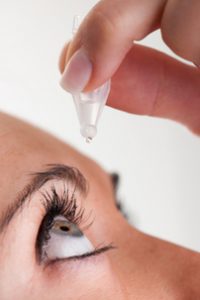WHAT IS DRY EYE DISEASE?
Dry eye occurs when the eye does not produce tears properly, or when the tears are not of the correct consistency and evaporate too quickly. In addition, inflammation of the surface of the eye may occur along with dry eye. If left untreated, this condition can lead to pain, ulcers, or scars on the cornea, and even permanent loss of vision.

Dry eye can make it more difficult to perform some activities, such as using a computer or reading for an extended period of time, and it can decrease tolerance for dry environments, such as the air inside an airplane.
WHAT ARE THE TYPES OF DRY EYE?
Aqueous tear-deficient dry eye is a disorder in which the lacrimal glands fail to produce enough of the watery component of tears to maintain a healthy eye surface.
Evaporative dry eye may result from inflammation of the meibomian glands located in the eyelids. These glands make the lipid or oily part of tears that slows evaporation and keeps the tears stable.
Dry eye can be associated with:
- Inflammation of the surface of the eye, the lacrimal gland, or the conjunctiva
- Any disease process that alters the components of the tears
- An increase in the surface of the eye, as in thyroid disease when the eye protrudes forward
- Cosmetic surgery, if the eyelids are opened too widely
WHAT ARE THE SYMPTOMS OF DRY EYE?
- Stinging or burning of the eye
- A sandy or gritty feeling as if something is in the eye
- Episodes of excess tears following very dry eye periods
- A stringy discharge from the eye
- Pain and redness of the eye
- Episodes of blurred vision
- Heavy eyelids
- Inability to cry when emotionally stressed
- Uncomfortable contact lenses
- Decreased tolerance of reading, working on the computer, or any activity that requires sustained visual attention
- Eye fatigue
WHO IS LIKELY TO DEVELOP DRY EYE?
Elderly people frequently experience dryness of the eyes, but dry eye can occur at any age. Nearly five million Americans 50 years of age and older are estimated to have dry eye. Of these, more than three million are women and more than one and a half million are men. Tens of millions more have less severe symptoms. Dry eye is more common after menopause. Women who experience menopause prematurely are more likely to have eye surface damage from dry eye.
HOW IS DRY EYE TREATED?
Depending on the causes of dry eye, your doctor may use various approaches to relieve the symptoms.
Dry eye can be managed as an ongoing condition. The first priority is to determine if a disease is the underlying cause of the dry eye (such as Sjögren’s syndrome or lacrimal and meibomian gland dysfunction). If it is, then the underlying disease needs to be treated.
Restasis (Cyclosporine) and Xiidra are prescription drugs available to treat dry eye. They may take three to six months for the medication to work. In some cases of severe dry eye, short term use of corticosteroid eye drops that decrease inflammation is required.
If dry eye results from taking a medication, your doctor may recommend switching to a medication that does not cause the dry eye side effect.
If contact lens wear is the problem, your eye care practitioner may recommend another type of lens or reducing the number of hours you wear your lenses. In the case of severe dry eye, your eye care professional may advise you not to wear contact lenses at all.
Another option is to plug the drainage holes, small circular openings at the inner corners of the eyelids where tears drain from the eye into the nose. Lacrimal plugs, also called punctal plugs, can be inserted painlessly by an eye care professional. The patient usually does not feel them. These plugs are made of silicone or collagen and are reversible.
In some cases, a simple procedure, called punctal cautery, is recommended to permanently close the drainage holes. The procedure helps keep the limited volume of tears on the eye for a longer period of time.
In some patients with dry eye, supplements or dietary sources (such as tuna fish) of omega-3 fatty acids (especially DHA and EPA) may decrease symptoms of irritation. The use and dosage of nutritional supplements and vitamins should be discussed with your primary medical doctor.
WHAT CAN I DO TO HELP MYSELF?
- Use artificial tears, gels, gel inserts, and ointments – available over the counter – as the first line of therapy. They offer temporary relief and provide an important replacement of naturally produced tears in patients with aqueous tear deficiency. Avoid artificial tears with preservatives if you need to apply them more than four times a day or preparations with chemicals that cause blood vessels to constrict.
- Wearing glasses or sunglasses that fit close to the face (wrap around shades) or that have side shields can help slow tear evaporation from the eye surfaces. Indoors, an air cleaner to filter dust and other particles helps prevent dry eyes. A humidifier also may help by adding moisture to the air.
- Avoid dry conditions and allow your eyes to rest when performing activities that require you to use your eyes for long periods of time. Instill lubricating eye drops while performing these tasks.
